Why have presidents visited the SouthCoast? Campaigns, summer homes, funerals and more
- Oops!Something went wrong.Please try again later.
- Oops!Something went wrong.Please try again later.
- Oops!Something went wrong.Please try again later.
The SouthCoast will be getting a high-profile visitor on Wednesday.
President Joe Biden is expected to make a stop in Somerset at the shuttered Brayton Point power plant.
The White House confirmed the president's southeastern Massachusetts plans at Brayton Point, where he will "deliver remarks on tackling the climate crisis."
Biden's trip is the latest in a long line of commander-in-chief crusades to the SouthCoast. As we prepare to welcome our current sitting president, we recount history of POTUS stops in the area:
What we know: President Biden will be in Somerset this week visiting Brayton Point. Here's why.
FALL RIVER
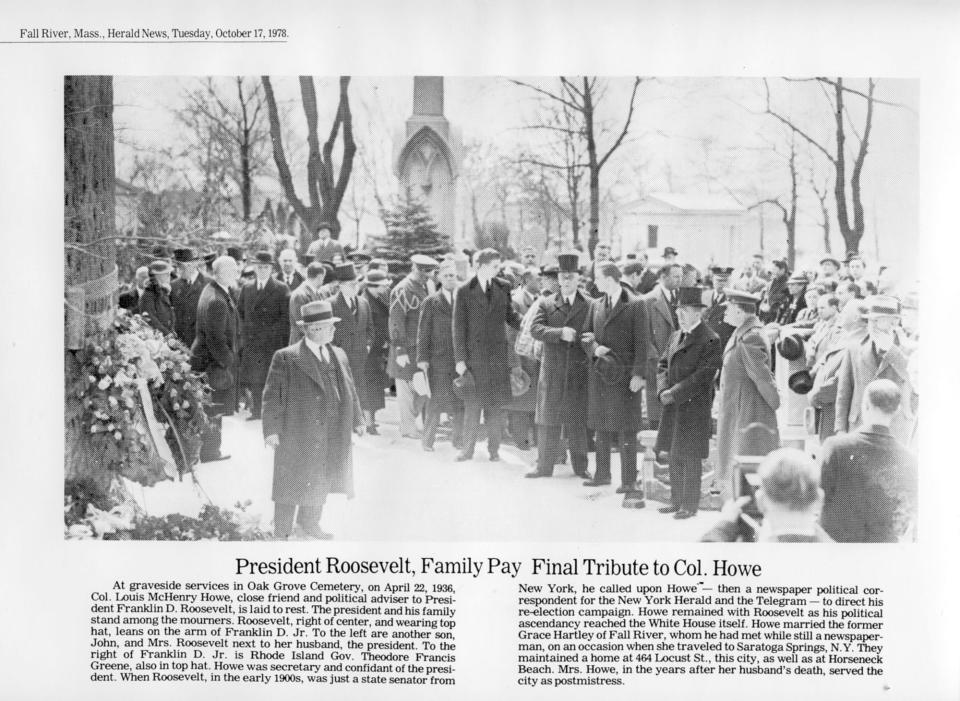
William Howard Taft
William Howard Taft visited Fall River on June 23, 1911, for the city’s Cotton Centennial Festival, commemorating 100 years of cotton cloth production in the city. Taft also spoke at South Park, telling the crowd, “I congratulate you again on your wonderful progress and the happiness of your individual citizenship on every side, and wish you Godspeed in making greater steps forward in the next 100 years.” It is believed Taft’s trip attracted roughly 150,000 people.
Franklin Delano Roosevelt
Franklin Delano Roosevelt paid tribute to his close friend and political adviser Louis McHenry Howe, who was laid to rest at Oak Grove Cemetery on April 22, 1936. He later spoke before a crowd of 22,000 at South Park, now known as Kennedy Park. Although a native of Indiana, Howe was buried in Fall River because his wife, Grace Hartley Howe, was a city native.
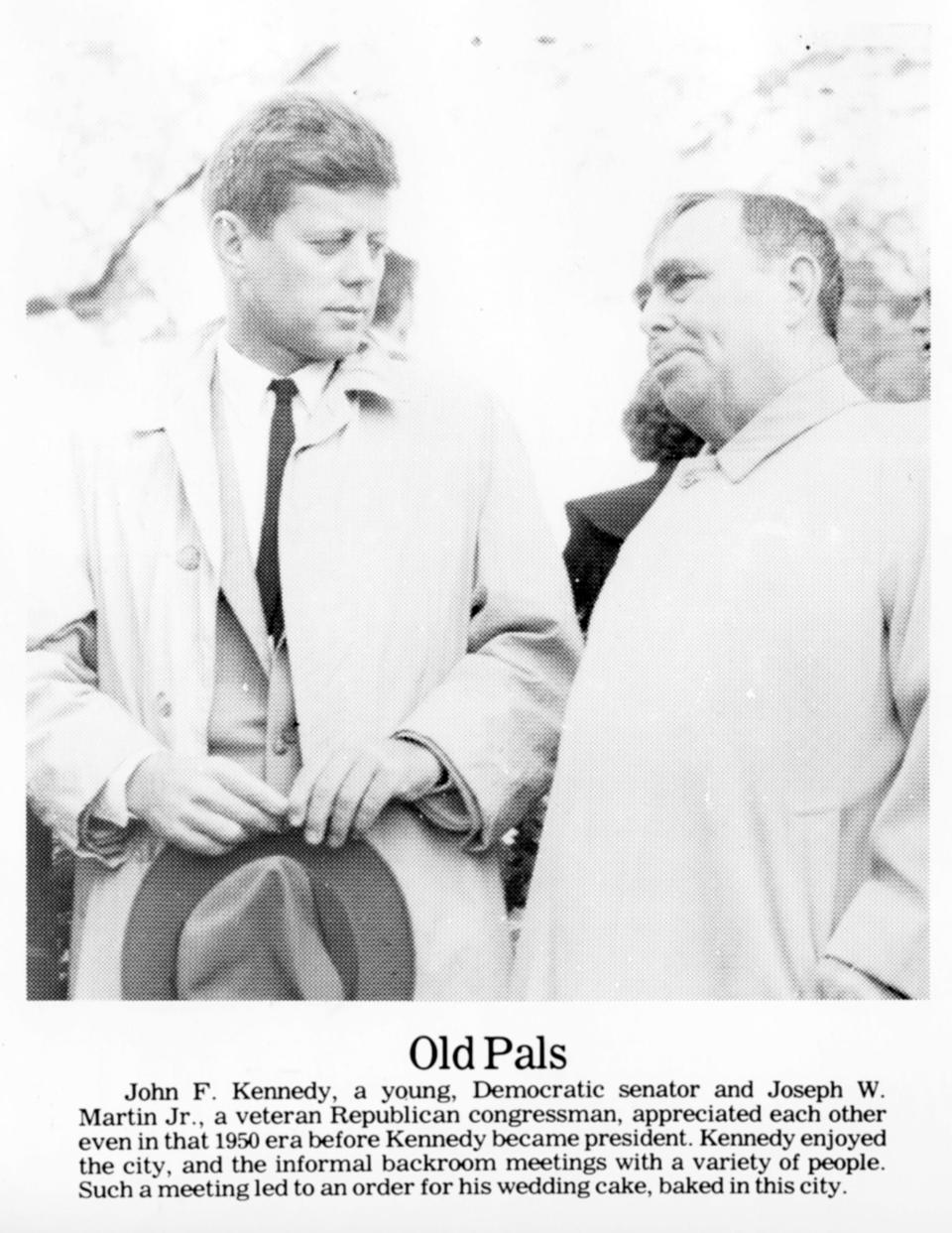
John F. Kennedy,
John F. Kennedy, then a young, Democratic Massachusetts senator, made a handful of visits to Fall River in the 1950s. Kennedy enjoyed the Spindle City, and the informal backroom meetings with a variety of people. Such a meeting led to an order for his wedding cake, which was baked in the city.
Harry S. Truman
Harry S. Truman made a campaign stop at the Brightman Street Bridge on Oct. 18, 1952, stumping for Democratic presidential nominee and Illinois Gov. Adlai Stevenson.
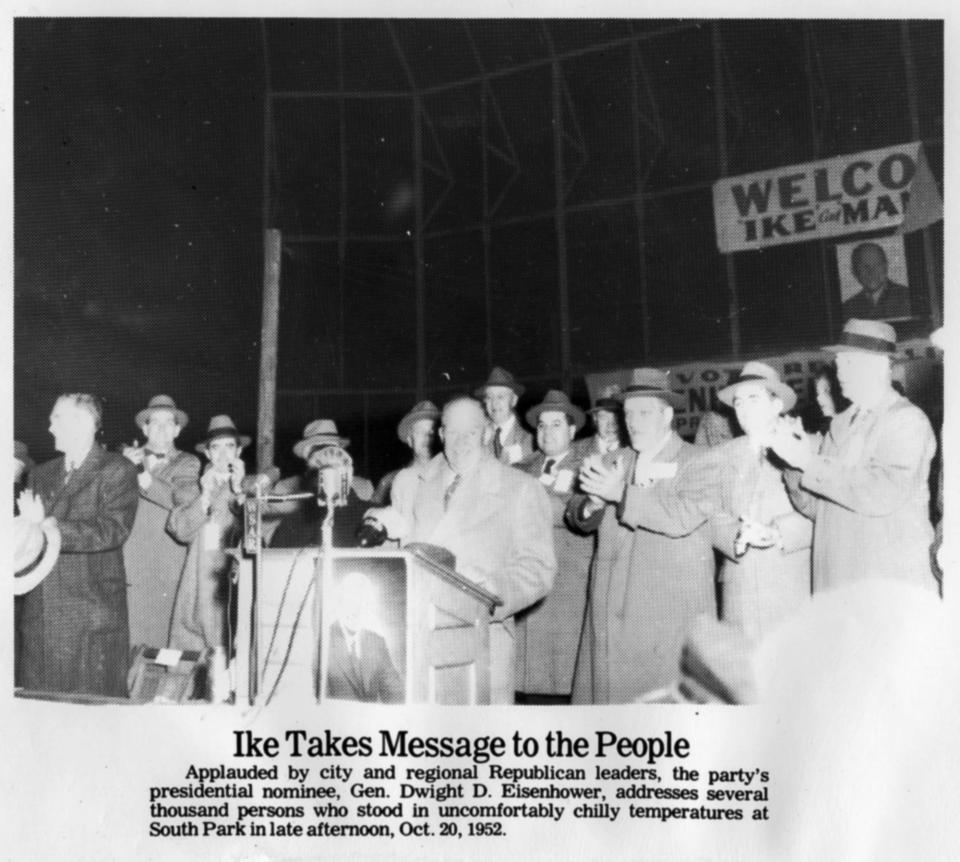
Dwight D. Eisenhower
Applauded by city and regional Republican leaders, the party's presidential nominee, Gen. Dwight D. Eisenhower, addressed several thousand people who stood in chilly temperatures at South Park in the late afternoon of Oct. 20, 1952.
Jimmy Carter
Jimmy Carter, then one of several candidates for the Democratic presidential nomination, visited Fall River in 1975.

President Bill Clinton
On Sept. 28, 1996, President Bill Clinton choose Kennedy Park to make a campaign stop and endorse local Democrats John Kerry and James McGovern for the upcoming election. He greeted the crowd with a hearty "Obrigado Fall River!" and after a 20-minute speech worked his way into the crowd. "I have been all over the world, This is my first trip here. If I had known what I was missing, I would have been here sooner," Clinton said.
Polk, Fillmore and Harrison
A trio of 19th-century presidents also visited Fall River — James K. Polk in the 1840s, Millard Fillmore in the 1850s and Benjamin Harrison in the 1890s.
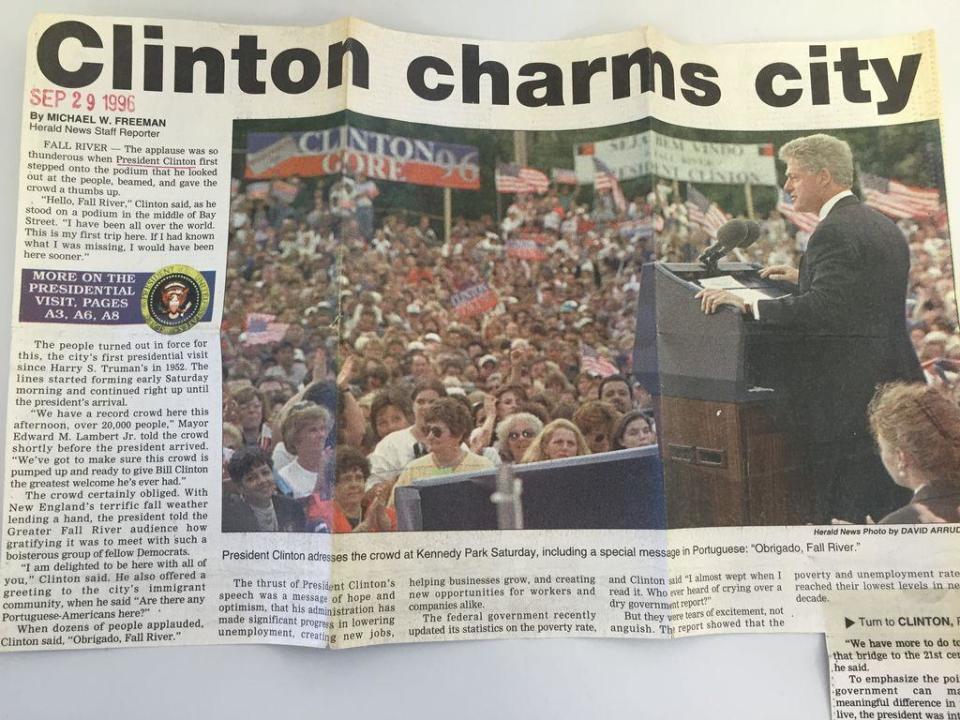
TAUNTON
John Adams
John Adams was a circuit lawyer in July 1762 when he visited Taunton. He visited his friend who lived in the house on High Street that is currently used as the rectory for the St Thomas Church. Adams would later become the second U.S. president.
James Knox Polk
The first sitting U.S president who came to Taunton was James Knox Polk when he visited Taunton by train in 1848.
POTUS in the Silver City: A history of presidential visits to Taunton
Abraham Lincoln
Abraham Lincoln visited Taunton in September 1848 while campaigning for General Zachary Taylor who would win the election in 1848 and later become the 12th President. Lincoln, of course, would later become the 16th president.

Grover Cleveland
Grover Cleveland came by Taunton during his term, as he had a summer home in Marion.
Theodore Roosevelt
Former President Theodore Roosevelt visited Taunton in April 1912 while campaigning for president.
William Howard Taft
The 27th U.S. President, William Howard Taft, visited Taunton while in office in April 1912 while campaigning for re-election.

Many presidents hit the campaign stops in Taunton
The 32nd president, Franklin Delano Roosevelt, campaigned in Taunton in 1936.
The 33rd president, Harry S. Truman, visited Taunton twice while president first in 1948 and then in 1952 while campaigning for Adlai Stevenson.
Gen. Dwight Eisenhower visited Taunton while campaigning for president in the fall of 1952, when he won election to become the 34th President.

John F. Kennedy visited Taunton often as he was a local senator and congressman. He campaigned in Taunton with Eisenhower in 1952.
Then-Georgia Gov. Jimmy Carter visited Taunton in 1975 while campaigning for president. He talked to reporters at the Taunton Daily Gazette.
Former President Bill Clinton visited Taunton in the fall of 2010, while campaigning for the re-election of Congressman Barney Frank. Clinton made a speech at Taunton High School.
Hillary Clinton got a boost from her husband, former President Bill Clinton, in 2016. The former two-term president stopped off at Benjamin A. Friedman Middle School as part of a day-long, four-city tour in support of his wife's bid for her Democratic party's nomination against Bernie Sanders.
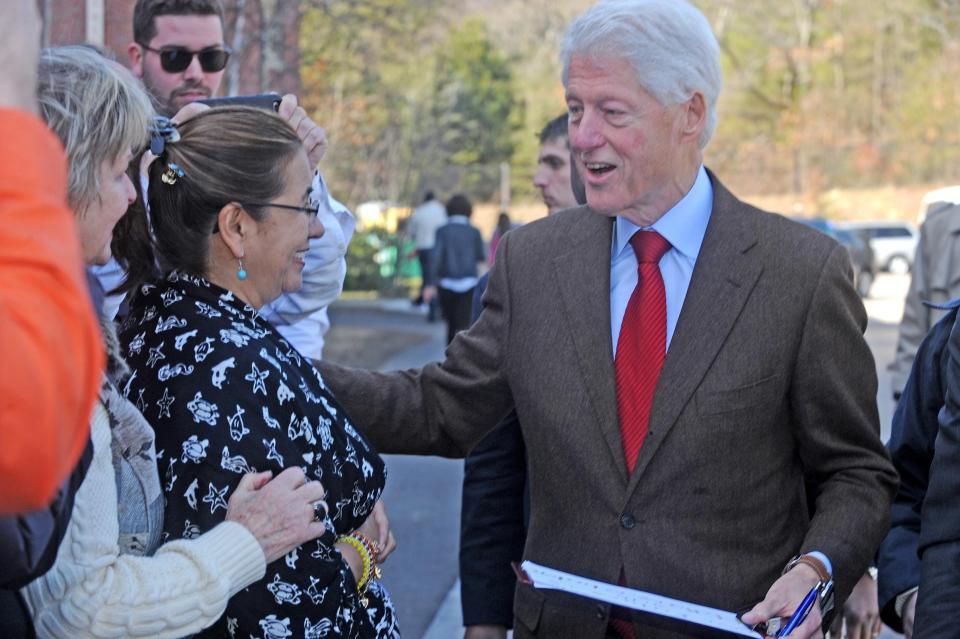
NEW BEDFORD
Franklin Delano Roosevelt
Franklin Delano Roosevelt could look back on his childhood and youth and recall visiting many times at the Delano homestead in Fairhaven, the ancestral home of the family of his mother, Sara, a child of affluence in a family whose wealth had come from the China trade. His own longtime personal secretary, Louis McHenry Howe, the man who many claimed was the brains behind Roosevelt's political rise, had married a Fall River girl, Grace Hartley. Franklin and Eleanor Roosevelt would pay several visits to the Howe's Locust Street home in Fall River and their summer cottage at Horseneck Beach in Westport.
Abraham Lincoln
Abraham Lincoln was completing his one and only term in the U.S. House of Representatives in 1848 when he came to New Bedford as a campaign speaker. The Whig Party member, who opposed the extension of slavery, came to New Bedford to speak on behalf of his party's standard bearer for president, Zachary Taylor, a Louisiana plantation owner who had made a name for himself in the Mexican War.
John Adams
John Adams probably visited the city more than once, including Sept. 27, 1849. He was 76 at the time, and was led from the train station by a crowd of torch-bearing partisans. Adams spoke at City Hall and decried those who would classify the American experiment in Democracy as a failure.
Ulysses S. Grant
President Ulysses S. Grant, who led Union armies to victory in the Civil War, was the nation's 18th president in 1874 when he paid New Bedford a visit. The president, his wife, Julia, and a daughter, along with Secretary of War William W. Belknap and his family, were on a summer vacation at Oak Bluffs on Martha's Vineyard. The presidential party to New Bedford came aboard the ferry Monohanset, and as they passed Fort Phoenix a 21-gun salute sang out from the fort's ramparts. The welcoming squad contained many Union veterans who had served directly or indirectly with the quiet unassuming man, whose dogged determination had finally sapped the strength of the Confederacy. Grant and his party were given a rousing reception at old City Hall, which today is the New Bedford Free Public Library.
Grover Cleveland
President Grover Cleveland's love of fishing drew him to Southeastern Massachusetts, and he twice rented summer cottages in Marion before in 1891 purchasing Gray Gables, a large shingled cottage at Monument Beach surrounded by several acres of land and easy access to the railroad lines.
William Howard Taft and Theodore Roosevelt
President William Howard Taft's April 1912 appearance in New Bedford came during a rift in the Republican Party — former President Theodore Roosevelt would challenge the incumbent and later broke off in the Bull Moose Party — that ultimately led to the election of Woodrow Wilson that fall.
Theodore Roosevelt had preceded Mr. Taft into the city for his own campaign appearance.
Calvin Coolidge
Calvin Coolidge most assuredly must have visited the New Bedford-Fall River area during his tenure as governor of Massachusetts, but it does not appear he made any official visits as the nation's 30th president.
Harry S. Truman and Dwight D. Eisenhower
President Harry S. Truman and Dwight D. Eisenhower made appearances within a few days of each other during the presidential campaign of 1952. Mr. Truman in 1952 was an outgoing president on Oct. 18, 1952, but was making a New England campaign swing on behalf of Adlai Stevenson when he spoke at South Park in Fall River. It was a relatively lukewarm reception, as only about 3,000 showed up to hear his speech attacking Republicans as "working with the private power lobby to defeat Democratic attempts to provide cheap power for New England.
General Eisenhower's reception, in contrast, was overwhelming, as more than 40,000 people lined the streets of New Bedford to view his motorcade from the Pearl Street railroad station to Buttonwood Park where between 8,000 and 25,000 gathered to hear the general attack "the-never-had-it-so good" theme of the Democrats. He was greeted by a crescendo of "We Want Ike," as he rose to speak at Buttonwood Park.
Ronald Reagan
Ronald Reagan made one of his political gaffs during his campaign appearance, when he downplayed the stranglehold Middle East oil held on the national economy by saying that Alaska's North Slope held more oil reserves than Saudi Arabia.
Bill Clinton
Bill Clinton held a midday rally at Buttonwood Park on Election Day in 2016, drawing a crowd of more than 1,000.
This article originally appeared on The Herald News: Presidents visit the SouthCoast MA: Campaigns, rallies, summer homes

